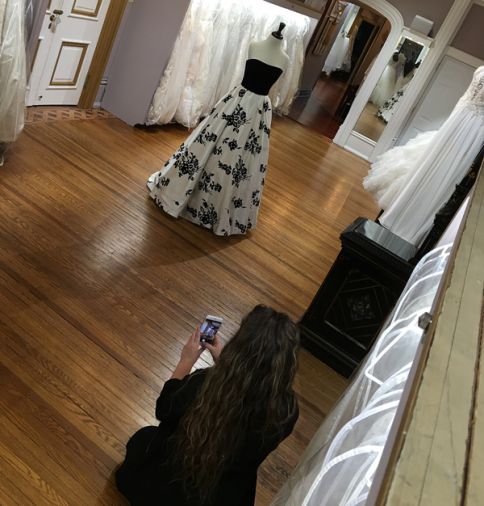There’s no escaping social media; it’s become integral to modern business and everyday life.
Because Facebook, Instagram, Twitter et al. are so commonly used in the bridal world, it’s easy for bad habits to creep in when managing these pages. Below are six of the most common negative practices to watch out for, as well as helpful suggestions for positive change.
1. STOP: Thinking social media is free!
It might be the most common mistake: Because setting up a social-media account or posting a status update doesn’t come with the same price tag as television ads, print ads or direct mail, it’s easy to view these communication tools as free.
“One simple thing small businesses can do is change their mindset about social media,” says Gregory Hoplamazian, associate professor in the Department of Communications at Loyola University in Maryland. “It is not something one can do on the side, for free, with little investment.”
Hoplamazian continues, “Businesses should understand that to do it well comes with a cost - paying an employee or hiring a social-media agency. And the cost of doing it poorly is high, as customers judge organizations based on what they see online and the investment these organizations choose to make.”
So make sure you leave room in your marketing budget for social-media promotion and posting. It doesn’t have to be a large amount, especially when you are just beginning to test the waters, but it needs to be something.
Speaking of investment, some independent bridal salons hire professionals to design, set up and/or manage their social-media platforms. If this isn’t financially feasible for you, another option is purchasing a social-media audit from a professional agency. An audit can assess what platforms might work best for your needs, which can be self-managed, and, importantly, which you should consider spending money on.
2. STOP: Selling, selling, selling!
Social-media content should not be dominated by the hard sell. It’s not all about you, you, you after all!
If all of your social-media communications are about your products, your big sale and how great you are, you’re missing the whole point of these platforms.
Primarily, social media should be a tool for building and maintaining relationships. Rather than constant self-promotion, the goal should be to reach your target audience and engage them in conversation. That conversation should be helpful, informative and interesting. Make it easy for people to comment and post on your pages, and also share content from other sources that your fans and followers can use. The information you share should reflect your store’s brand and personality and give people a reason to keep coming back.
That’s not to say you can’t post, tweet or blog about the beautiful new dresses that just arrived or announce the appearance of a top designer at a trunk show. It does mean that you should spend the bulk of your social-media efforts on getting a conversation going instead of delivering a sales pitch, however.
A general rule of thumb is to aim for 80 percent informative, entertaining, engaging content, and 20 percent business-related posts.
3. STOP: Mixing personal and business content!
It may seem harmless to post benign personal stuff on your store’s social-media accounts but this is a bad, potentially damaging habit.
First, there are privacy issues - certain information you and your staff probably don’t want out there for public consumption, such as your address, your vacation schedule, or even where your kids go to school. Second, social-media activity for your business is about building relationships and establishing your place in the community; this simply isn’t the place for posts about your son’s soccer game. Finally, if customers perceive your personal posts as frivolous this could cause them to make assumptions about your financial status.
“Everyone wants to support businesses with product that they use and love to see people thrive, but posting what is perceived as boasting can cause clients to reevaluate your price points and whether you ‘need’ their business,” warns Lauren Mink of social-media marketing firm TransMedia Group.
Additionally, anything controversial – and today, what isn’t? – can cause anyone passionate about the other side to unfollow your account or even view your business as a perceived enemy. And unfortunately, a loss of followers could reflect in your revenue and/or in acquiring other business prospects.
“A solid social-media presence is mandatory in today’s world, with millennials becoming the majority generation, and a drop in your presence is vulnerability and causes people to reevaluate the validity and potential of your business,” Mink says.
The solution? Establish distinct social-media accounts for your company. Even if you’re a small, individually run business, you should have a separate, dedicated presence on social-media channels for personal and business use.
Reminder: this works both ways, too. After all, your friends don’t want to be bombarded with business posts; they came to engage with you!
4. STOP: Ignoring feedback!
You must take the time to at least acknowledge what fans and followers post on your sites, both good and bad. Since you’ve taken the trouble to activate a social-media platform and invite users in, you’re missing an opportunity to let them get to know the real you when you don’t actively respond and add your thoughts to the mix.
Take the time to respond to comments from other posters. This doesn’t have to be a 24/7 project but there needs to be some consistency. Regularly get involved in the discussion and don’t be afraid to ask questions that can elevate the conversation either. Make sure that your content is interesting and compelling. Otherwise, why should anyone visit your sites?
Social-media conversations should be viewed as personal interactions; the secret to success is learning how to listen, really listen, to what other people are saying. They’ll tell you what they’re interested in, what’s important to them, and what they really want to know. For example, users may not respond to a post about the history of your company but may highly value learning about your support of a charitable cause.
But what if those comments are negative? You should still respond! Turning a blind eye to criticism can damage your brand. Not everyone will love your store, your staff, your products, or the experience they had on your premises. While it may be tempting to ignore those bad comments and hope they’ll go away, this is wishful thinking. The reality is that any follower or visitor could see this critique, and as such it’s imperative to have a response plan.
On a regular basis, schedule checks of review sites as well as your own social-media accounts for commentary. Ideally, if you don’t have a designated social-media director, someone should be watching sites for potential problems. Then address them! Reach out to users with complaints and offer to talk about any issues they have.
Even commenting that you are sorry they had a bad experience and would like to discuss it is a positive action. Other site visitors will see at least an attempt to rectify a bad experience. In addition, encourage positive reviews whenever possible, including featuring testimonials on your website and posting shared photos of satisfied shoppers enjoying the moment.
5. STOP: Setting it and forgetting it!
Some small businesses assume you have to be on every social-media platform that pops up, so they create a Facebook, Twitter, Instagram, Pinterest or other account and then don’t maintain an active presence.
So their presence is, in fact, really more of an absence. This is far worse than not being on the site at all. The main problem is the subtle message it communicates to customers when they visit your page: This store is out of date, takes forever to respond, and likely won’t carry current, attractive styles.
Is that fair and/or accurate? Of course not. But assumptions rarely are.
“To exist on social media isn’t enough; you have to be constantly posting new content,” Hoplamazian says. “If an organization doesn’t think it can actively manage its channels, it is likely best to not start an account in the first place, and to focus their energy on only those platforms they can actively maintain.”
This is particularly important because like it or not, your social-media presence will be compared to your competitors’.
“If you have a Facebook page, but you never post there, if your most recent post is from a year ago, and most recent pictures are from six months ago, and your competitor’s Facebook page is constantly updated, lots of comments, lots of interaction, that’s going to make them look like a more responsive brand, and differentiate them over you,” he says.
You should view each social-media channel as fundamentally different, especially in terms of how you can provide content. One or two sites may be better suited to your business and the people you want to engage than others.
Essentially, “choose a single media platform that you can benefit from most and then do a really good job with it,” Hoplamazian says.
6. STOP: Assuming young employees are great at social media!
Just because someone was born into Gen Z or the millennial generation does not automatically mean they are the perfect person to run your salon’s social-media accounts!
Far too many owners assign their youngest employees these duties “because that is what they know.” And while some may in fact turn out to be very good, this is not always the case.
“The reality is that knowing how to use a platform for fun doesn’t mean one knows how to use it for strategic communication,” says Hoplamazian, who teaches a graduate course in emerging media.
After all, what gets posted on social media is very public, so it’s essential the person posting must have a good sense of your salon’s overall brand, strategy and long-term vision.
“Companies should put people in charge if they have some kind of formal training or experience managing social media on behalf of an organization,” he says. “This involves knowledge of legal and social issues, as well as practical content creation skills, and knowledge of how to use analytic tools to assess success.”
In other words, the job should go to the best qualified person, and that may or may not necessarily correlate to age.
As the importance of social media in small business expands, you must step back and take a hard look of how you are using each platform your salon has a presence on, and create an action plan. The bad habits outlined in this story are the most common but do not constitute a complete list. It’s crucial to keep your eyes, ears and mind open when evaluating your online presence. If something isn’t working, call attention to it immediately so a small blip on the radar does not blow up into an overwhelming, seemingly unmanageable long-term problem.






